The villages of Tegryn and Llanfyrnach are two small villages situated to the east of Crymych, in north Pembrokeshire. Tegryn is the largest village and is the home of Llwynyrhwrdd Welsh Independent Chapel; whilst Llanfyrnach, at the head of the River Tâf, is the home of St. Brynach’s Church and contains within its Parish the village of Crymych and the hamlets of Hermon, Glandwr and Pentre Galar. There is a small Norman motte close to the church, which is late Victorian, but dates back to at least the 6th Century AD. I do not know if there are any war memorials in Tegryn, Llanfyrnach or Glogue, although nearby Crymych has a war memorial which commemorates all of the men of the area who fell during both World Wars. This page commemorates the men of the area around Llanfyrnach. If there are any war memorials within the Church there, I would be grateful for any photographs of them.
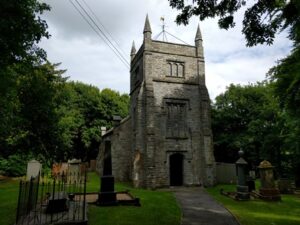
The Great War, 1914-1918
Thomas Evans, Corporal, 432900, Canadian Infantry. Thomas was born on 18 November 1877 the son of John and Mary Evans, of Tegryn. He had lived in London before the war, where he was a Policeman with the Metropolitan Police. Thomas emigrated to Canada prior to the war, and enlisted there at Edson on 21 January 1915 into the Canadian Infantry. Thomas sailed for England where he joined the 49th Battalion (Edmonton), which was attached to the 7th Canadian Brigade, 3rd Canadian Division. The Division formed in France during December, 1915. They moved to positions south of Ypres, and fought there in June 1916 at Mount Sorrel. They then moved south, taking up positions on the Somme during September, 1916 and they fought there at the Battle of Flers-Courcelette, at Thiepval, Le Transloy and on the Ancre. In April the Division fought during the Arras Offensive, at the Battle of Vimy Ridge, then during the Third Battle of the Scarpe and the Battle of Hill 70 near Loos, before moving back to Ypres. They fought here during Third Ypres, at the Second Battle of Passchendaele, where they successfully managed to capture Passchendaele Village. Thomas was killed in action here on 30 October 1917, aged 40. He is buried at Passchendaele New British Cemetery, Belgium.
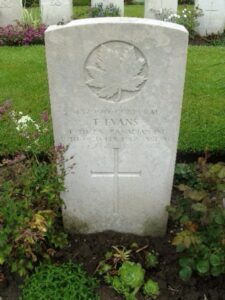
Haydn Griffiths, Private, 9845, Royal Fusiliers. Haydn was born at Llanfyrnach, the son of William and Sarah Griffiths, of Bwlchgwynt, Llanfyrnach. He enlisted at Merthyr into the 8th Battalion, Royal Fusiliers. The Battalion was attached to 36 Brigade, 12th (Eastern) Division. The Division landed at Boulogne on 31 May 1915, and took over the line at Ploegsteert Wood. They then moved south and fought in the Battle of Loos, and the subsequent actions of the Hohenzollern Redoubt, and remained there until March 1916. By June they were in position at the Somme, and attacked Ovillers on 2 July 1916. They then fought at Pozieres, which is where Haydn was killed in action on 3 August 1916, aged 20. Haydn has no known grave, and is commemorated on the Thiepval Memorial, France.
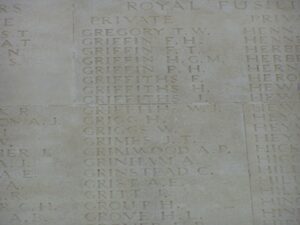
Joshua Cromwell Griffiths, Private, 440205, Labour Corps. Joshua was born in Penbryn in 1893, the son of James and Margaret Griffiths. The family later resided at Nant Neel Farm, Clydey. Very little is known of Joshua, but he initially served with the South Wales Borderers, with the service number 31232, before being downgraded medically, and posted to the Labour Corps. Joshua died at home of sickness on 25 March 1918, aged 25, and is buried at Capel Ifan Congregational Chapelyard.
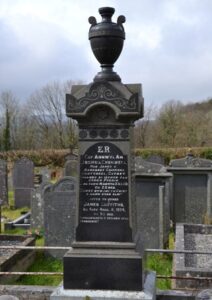
John Sidney James Havard, Private, 202031, South Lancashire Regiment. John was the son of David and Phoebe Havard, of College Green, Crymych. He enlisted at Crymych into the 2/4th Battalion, South Lancashire Regiment, which was attached to 172 Brigade, 57th (2nd West Lancs.) Division. The Division moved to France during February 1917, and moved to positions near Ypres, where they took part in the Second Battle of Passchendaele. In 1918 they took part in the 1918 Battle of the Scarpe, and at the Battle of Drocourt-Queant. John was wounded around this time, and evacuated, via the network of Casualty Clearing Stations, and via the Hospitals in France back to England for treatment. Sadly John died at home of his wounds on 28 October 1918. He was 25 years old and is buried at Bwlchygroes Calvinistic Methodist Chapelyard.
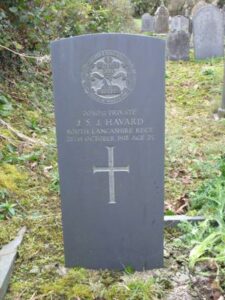
John Alfred Johnson, Private, 41567, Loyal North Lancashire Regiment. John was the son of John and Ruth Naomi Johnson, of Tynewydd, Star, Llanfyrnach. He enlisted at Cardiff into the 1/5th Battalion, Loyal North Lancashire Regiment, which was attached to 170 Brigade, 57th (2nd West Lancs.) Division. The Division moved to France during February 1917, and moved to positions near Ypres, where it took part in the Second Battle of Passchendaele. In 1918 it took part in the Battle of the Scarpe, and at the Battle of Drocourt-Queant. The Division fought on the Hindenburg Line during the Battle of the Canal du Nord, and it was during the advance to the Hindenburg Line and the Canal Du Nord that John was killed, on 30 August 1918. He was only 20 years old. John has no known grave, and is commemorated on the Vis-En-Artois Memorial, France.
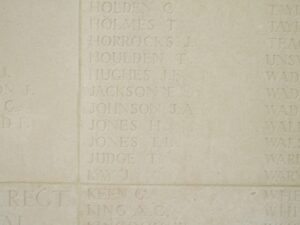
Daniel Jones, Private, 267113, Welsh Regiment. Daniel was born in Trelech, the son of George and Elizabeth Jones. He resided with his brother, John Jones, at Waterloo House, Trefach, Llanfyrnach prior to the war. Daniel enlisted at Carmarthen into the 1/6th Battalion, Welsh Regiment, which had been in France almost since the start of the war, and had become the Pioneer Battalion to the 1st Division. The Division fought at Loos in September 1915, and on the Somme in 1916. During 1917 it took part in the Battle of Arras, and also fought at Third Ypres, and was still in Flanders when the Germans launched their Lys offensive in April 1918. Daniel was killed in action on 8 May 1918 during the German Offensive. He was 37 years old, and is buried at Sailly-Labourse Communal Cemetery Extension, France.
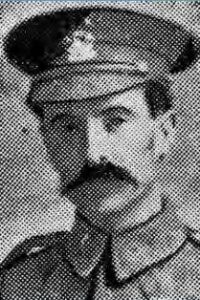
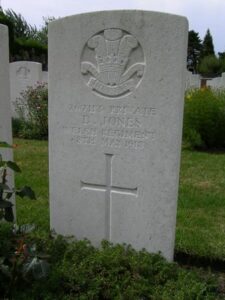
John Jones, Able Seaman, R/2903, Royal Naval Volunteer Reserve. John was born at Llanfyrnach on 28 July 1887, the son of Edward and Magdalen Jones. By 1911 he was lodging at Goat Street, Swansea, where he worked as a Draper. He had married Hanna, of 9, River Row, Brynmenyn prior to the war. John had served for nine years with the 7th Welsh (Cyclists) prior to being transferred into the Royal Naval Volunteer Reserve and was posted to Anson Battalion, 63rd (Royal Naval) Division on 30 August 1917. He joined the battalion on the Somme, just prior to a move north to Ypres, where the division was going to take part in the Passchendaele offensive. The division attacked alongside the Canadians on 26 November, capturing Varlet Farm and Banff House and saw heavy casualties during the fighting to capture Passchendaele Ridge. John survived the main battle, but was wounded towards the end of the entire offensive. He was brought back to the casualty clearing station at Dozinghem where he died of his wounds on 11 November 1917, aged 30. John is buried in Dozinghem Military Cemetery, Belgium.
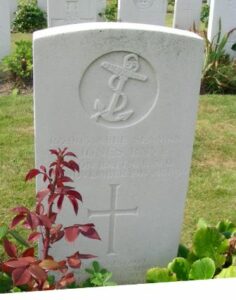
David Morris Owen, Private, 202676, Welsh Regiment. David was born at Clydey, near Llanfyrnach, the son of James and Anne Owen, of Glasfryn, Clydey. He enlisted at Llanelli into the army, and was posted to the 9th Battalion, Welsh Regiment, which was attached to 58 Brigade, 19th (Western) Division. The Division assembled around Bulford during September 1914, and crossed to France during July 1915, moving to positions near Loos. The Division fought during the opening attack of the Battle of Loos, and then moved to the Somme, where they took part in the second wave of the attack on Ovillers-La Boiselle on 1 July 1916, capturing the village at heavy cost, and fought through the Somme Battles of Pozieres and the Ancre in 1916. They then moved North to Ypres, taking part in the Battle of Messines, and fought on the Menin Road and at Polygon Wood, before moving up to Broodseinde, Poelcapelle and Passchendaele Village itself. The Division was moved south to the Arras area over the winter of 1917/1918. David took ill here and sadly died on 4 March 1918, aged 23. He is buried at Rocquigny-Equancourt Road British Cemetery, Manancourt, France.
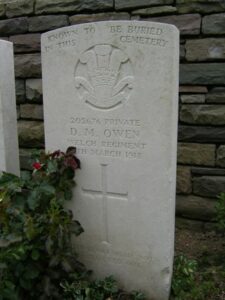
William John Phillips, Private, 43501, King’s Liverpool Regiment. William was the son of Phillip and Bridget Phillips, of Blaenwaun, Trelech. He enlisted at Carmarthen into the Welsh Regiment, but later transferred into the 24th Battalion, King’s Liverpool Regiment, which was a Home Service Battalion. William died of sickness in hospital at Nottingham on 14 June 1916, aged only 19. He was brought home for burial at Trelech (Rock) Congregational Chapelyard.
Evan Rees, Private, 73644, Royal Welsh Fusiliers. Evan was the son of David and Sarah Rees, of Giblin Cenarth, Ponteuney, Newcastle Emlyn, and lived in Llanfyrnach prior to the war. He enlisted at Carmarthen into the 9th Battalion, Royal Welsh Fusiliers, who were attached to 58 Brigade, 19th (Western) Division. The Division crossed to France during July 1915, and moved to positions near Loos. The Division fought during the opening attack of the Battle of Loos, and then moved to the Somme, where they took part in the second wave of the attack on Ovillers-La Boiselle on 1 July, capturing the village at heavy cost, and fought through the Somme Battles of Pozieres and the Ancre in 1916. They then moved North to Ypres, taking part in the Battle of Messines, and fought on the Menin Road and at Polygon Wood, before moving up to Broodseinde, Poelcapelle and Passchendaele Village itself, before moving to the Somme area to rest and rebuild. Evan was killed in action on the Somme on 4 January 1918, aged 23. He has no known grave, and so is commemorated on the Thiepval Memorial.
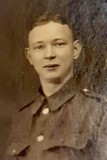
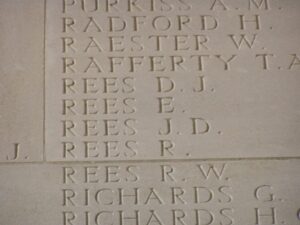
Tommy Thomas, Private, 1003, Australian Imperial Force. Tommy was born at Llanfyrnach in 1889, the son of Thomas and Mary Thomas. Thomas and Mary later moved to 1, Bridge Street, Port Talbot, while Tommy went to live at North Gate Terrace, Cardigan, where he worked as a carpenter. Tommy emigrated to Australia prior to the war, and enlisted at Queensland on 17 June 1915 into the 25th Battalion, Australian Infantry. The 25th Battalion was raised at Enoggera in Queensland in March 1915 as part of the 7th Brigade, leaving Australia in early July 1915. It trained in Egypt during August, and in September 1915 landed at Gallipoli, where it reinforced the depleted New Zealand and Australian Division. The 25th Battalion left the peninsular on 18 December 1915. After further training in Egypt, the 25th Battalion proceeded to France, landing on 19 March 1916, where it became attached to the 2nd Division. It took part in its first major battle at Pozières between 25 July and 7 August in the course of which it suffered 785 casualties. Tommy was wounded on 31 August, suffering multiple gunshot wounds, and was evacuated to the 1st Australian General Hospital at Rouen. He died of his wounds on 15 September 1916, aged 28, and is buried at St. Sever Cemetery, Rouen, France.
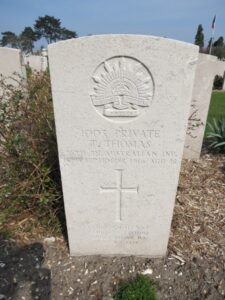
Thomas Walters, Private, T/312433, Army Service Corps. Thomas was the son of Thomas and Hannah Walters, of Rhyd, Aberwern, Meidrim. He married Mary B. James in 1913, and the couple resided at Brynteg, Tegryn, Llanfyrnach. Thomas enlisted at Bath on 24 June 1916 into the Army Service Corps. Thomas was posted to France the following year, and worked as a Packer and Loader. He took ill soon after arriving at the front and died of meningitis at No 2 General Hospital, Le Havre on 13 May 1917, aged 26. He is buried at Ste. Marie Cemetery, Le Havre, France.
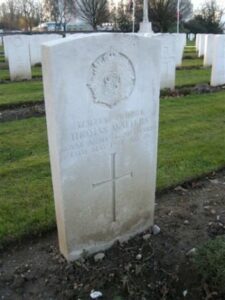
World War Two, 1939-1945
William MacLarty, Chief Engineer Officer, Merchant Navy. William was born in Lochgilphead, Scotland in 1901, the son of Duncan and Annie McLarty. He had entered the Merchant Navy as a young man and had married Beatrice Cockburn Hay, of Edinburgh, prior to the war. William served aboard the Glasgow registered cargo ship SS The Duchess. William was drowned when The Duchess was sunk in a collision with the SS Trefusus off the west coast of Scotland on 11 November 1940. He was 39-years-old and is commemorated on the Tower Hill Memorial, London. His wife was a midwife who lived in Llanfyrnach after the war and married Harold Taylor in 1960. She died in 1996, aged 84.
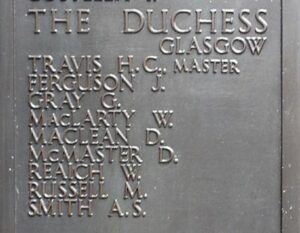
Benjamin Edwin Nicholas, Leading Aircraftman, 526309, Royal Air Force. Benjamin was the son of William Nicholas, and of Sarah Nicholas, of Tegryn, and served with 228 Squadron, Royal Air Force. The Squadron was a flying boat unit, which carried out anti-submarine and shipping patrols in the Mediterranean from its base at Kalafrana in Malta from October 1940. Benjamin was killed when his Short Sunderland N9020/W was lost over the Mediterranean on 1 November 1940 after being shot down by two Italian fighters. Benjamin was 24 years old, and is commemorated on the Alamein Memorial, Egypt.